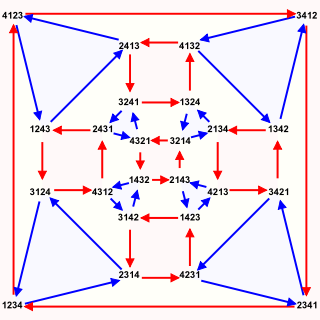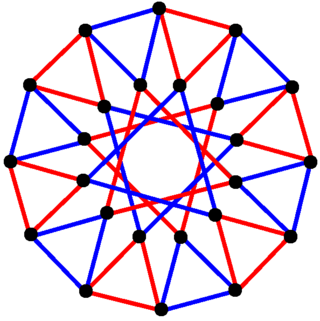Related Research Articles
In mathematics, more specifically in abstract algebra, the commutator subgroup or derived subgroup of a group is the subgroup generated by all the commutators of the group.

In abstract algebra, the symmetric group defined over any set is the group whose elements are all the bijections from the set to itself, and whose group operation is the composition of functions. In particular, the finite symmetric group defined over a finite set of symbols consists of the permutations that can be performed on the symbols. Since there are such permutation operations, the order of the symmetric group is .

In mathematics, an alternating group is the group of even permutations of a finite set. The alternating group on a set of n elements is called the alternating group of degree n, or the alternating group on n letters and denoted by An or Alt(n).

In mathematics, especially in the group theoretic area of algebra, the projective linear group (also known as the projective general linear group or PGL) is the induced action of the general linear group of a vector space V on the associated projective space P(V). Explicitly, the projective linear group is the quotient group
In mathematics, more specifically in group theory, a group is said to be perfect if it equals its own commutator subgroup, or equivalently, if the group has no non-trivial abelian quotients. In symbols, a perfect group is one such that G(1) = G, or equivalently one such that Gab = {1}.
In algebraic topology, a homology sphere is an n-manifold X having the homology groups of an n-sphere, for some integer . That is,

In mathematics, a reductive group is a type of linear algebraic group over a field. One definition is that a connected linear algebraic group G over a perfect field is reductive if it has a representation with finite kernel which is a direct sum of irreducible representations. Reductive groups include some of the most important groups in mathematics, such as the general linear group GL(n) of invertible matrices, the special orthogonal group SO(n), and the symplectic group Sp(2n). Simple algebraic groups and (more generally) semisimple algebraic groups are reductive.

In mathematical group theory, the Schur multiplier or Schur multiplicator is the second homology group of a group G. It was introduced by Issai Schur (1904) in his work on projective representations.
In mathematics, a spherical 3-manifoldM is a 3-manifold of the form

In mathematics, specifically in group theory, the phrase group of Lie type usually refers to finite groups that are closely related to the group of rational points of a reductive linear algebraic group with values in a finite field. The phrase group of Lie type does not have a widely accepted precise definition, but the important collection of finite simple groups of Lie type does have a precise definition, and they make up most of the groups in the classification of finite simple groups.

In mathematics, and especially in geometry, an object has icosahedral symmetry if it has the same symmetries as a regular icosahedron. Examples of other polyhedra with icosahedral symmetry include the regular dodecahedron and the rhombic triacontahedron.
In mathematics, the binary icosahedral group 2I or ⟨2,3,5⟩ is a certain nonabelian group of order 120. It is an extension of the icosahedral group I or (2,3,5) of order 60 by the cyclic group of order 2, and is the preimage of the icosahedral group under the 2:1 covering homomorphism
In mathematics, a class formation is a topological group acting on a module satisfying certain conditions. Class formations were introduced by Emil Artin and John Tate to organize the various Galois groups and modules that appear in class field theory.
In mathematics, an acyclic space is a nonempty topological space X in which cycles are always boundaries, in the sense of homology theory. This implies that integral homology groups in all dimensions of X are isomorphic to the corresponding homology groups of a point.

In mathematics, the binary tetrahedral group, denoted 2T or ⟨2,3,3⟩, is a certain nonabelian group of order 24. It is an extension of the tetrahedral group T or (2,3,3) of order 12 by a cyclic group of order 2, and is the preimage of the tetrahedral group under the 2:1 covering homomorphism Spin(3) → SO(3) of the special orthogonal group by the spin group. It follows that the binary tetrahedral group is a discrete subgroup of Spin(3) of order 24. The complex reflection group named 3(24)3 by G.C. Shephard or 3[3]3 and by Coxeter, is isomorphic to the binary tetrahedral group.

In mathematics, the special linear group SL(2, R) or SL2(R) is the group of 2 × 2 real matrices with determinant one:

In mathematics, a hyperoctahedral group is an important type of group that can be realized as the group of symmetries of a hypercube or of a cross-polytope. It was named by Alfred Young in 1930. Groups of this type are identified by a parameter n, the dimension of the hypercube.
In the mathematical area of group theory, the covering groups of the alternating and symmetric groups are groups that are used to understand the projective representations of the alternating and symmetric groups. The covering groups were classified in : for n ≥ 4, the covering groups are 2-fold covers except for the alternating groups of degree 6 and 7 where the covers are 6-fold.
In mathematics, an exceptional isomorphism, also called an accidental isomorphism, is an isomorphism between members ai and bj of two families, usually infinite, of mathematical objects, which is incidental, in that it is not an instance of a general pattern of such isomorphisms. These coincidences are at times considered a matter of trivia, but in other respects they can give rise to consequential phenomena, such as exceptional objects. In the following, coincidences are organized according to the structures where they occur.